3
Cathedral Spires & Cobblestones

Chichester Cathedral.
The magnificent cathedrals of England that long ago represented the power, wealth, and stature of sovereigns, can today be appreciated for their architectural beauty, breathtaking views, and sheer craftsmanship. Through the centuries many churches were subjected to dramatic changes and have become places of sanctuary. Today, the marks left at St. Thomas à Becket’s shrine by medieval pilgrims in Canterbury can still be touched, and many great works of art and literature have been inspired by Salisbury: Thomas Hardy and Anthony Trollope both set novels here and Turner and Constable captured the cathedral on canvas.
The streets and buildings that surround these monuments often reflect the long and colorful history of the cities, from winding lanes and tiny alleyways to cobblestoned-streets lined with gabled shop-fronts. Often, only a short walk away, are peaceful pathways leading into the surrounding countryside: head off on the Crab and Winkle way on a disused railway line in Canterbury or see the marshlands of Salterns Way, on a ramble from Chichester.
Canterbury

Immortalized by Chaucer in The Canterbury Tales, this city 60 miles (96km) southeast of London has been a religious epicenter for centuries—first for the Catholic Church and then for the Church of England. The city’s most famous feature, the soaring cathedral, began to rise in 1070. There, in a corner of the northwest transept, knights of Henry II murdered Thomas à Becket, then Archbishop of Canterbury, in 1170. Becket was canonized as a saint just 3 years later, at which point Canterbury became one of Europe’s most popular pilgrimage centers. For nearly 400 years, until Henry VIII had the shrine destroyed in 1538, pilgrims from throughout England and Europe flocked to this medieval spiritual center in search of miracles and a bit of adventure. Bell Harry, the graceful cathedral bell tower that guided the pilgrims across the fields and orchards of the Kent countryside, will lead you to this appealing city, too. Canterbury Cathedral remains one of England’s greatest and most venerable glories—its social and spiritual impact over the centuries has been profound.

Stained glass window depicting Thomas à Becket, Canterbury Cathedral.
However, this city on the banks of the River Stour was a prominent religious site long before Chaucer wove his 13th-century tales. In A.D. 595, a Benedictine monk known as Augustine of Canterbury was sent by Rome to convert the then-pagan English. He founded an abbey here in 597 that became one of Europe’s great centers of learning. Its evocative remains now spread across a grassy field not far from the cathedral; both the cathedral and the abbey are UNESCO World Heritage Sites.
Plan to spend the whole day in Canterbury because there’s plenty to do to fill the time. Alternatively, you can spend the afternoon taking in Kent’s sea breezes in the nearby coastal town of Whitstable, just a short train ride away.
Essentials
Visitor Information
The Tourist Information Centre, 12–13 Sun St. ( 01227/378-100; www.canterbury.co.uk), opposite Christchurch Gate near the cathedral, is open Monday through Saturday, 9:30am to 5pm, and Sunday, 9:30am to 4:30pm. There you can pick up a Canterbury Attractions Passport (£20 adults, £17 children), which admits you to the cathedral and abbey and two other sights of your choice.
01227/378-100; www.canterbury.co.uk), opposite Christchurch Gate near the cathedral, is open Monday through Saturday, 9:30am to 5pm, and Sunday, 9:30am to 4:30pm. There you can pick up a Canterbury Attractions Passport (£20 adults, £17 children), which admits you to the cathedral and abbey and two other sights of your choice.
Scheduling Considerations
Canterbury is popular year-round, but crowds swell in summer. If you want to visit the cathedral in relative peace, choose a weekday and arrive early. Alternatively, come late in the day and you might even catch Evensong, an atmospheric experience.
Getting There
By Train
Canterbury has two train stations, both within easy walking distance of the city center. Trains run to Canterbury from London Victoria every 30 minutes, and from Charing Cross around once an hour. The journey takes 11⁄2 hours and a round-trip ticket costs about £20.
By Bus
National Express ( 08717/818-178; www.nationalexpress.com) offers a frequent, direct bus service from London’s Victoria bus station to Canterbury’s bus station on St. George’s Lane, a few minutes’ walk from the cathedral. The trip takes 1 hour and 50 minutes; round-trip tickets cost £9 to £14.
08717/818-178; www.nationalexpress.com) offers a frequent, direct bus service from London’s Victoria bus station to Canterbury’s bus station on St. George’s Lane, a few minutes’ walk from the cathedral. The trip takes 1 hour and 50 minutes; round-trip tickets cost £9 to £14.
By Car
From London, take the A2 and then the M2. The trip takes about 2 hours. Much of the city center is pedestrian only, and so park in one of the public carparks at the edge of the city center, on Sturry Road, Wincheap, or New Dover Road.
Getting Around
Canterbury city center is easily walkable, but if you need to travel beyond the center taxis are usually available outside the train stations; or you can order a taxi by calling Lynx ( 01227/464-232) or Cabwise (
01227/464-232) or Cabwise ( 01227/712-929).
01227/712-929).
A Day in Canterbury
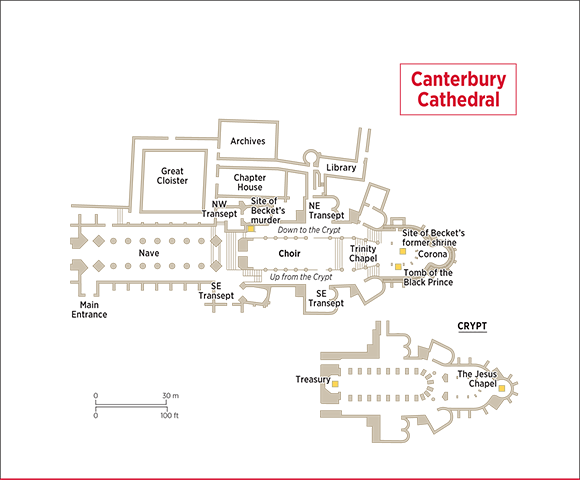
For a pilgrim’s tour of Canterbury, enter the city through the Westgate, where St. Peter’s Street crosses the River Stour. The gate has stood guard over the road to and from London for some 600 years, and hundreds of thousands of medieval pilgrims, on their way to visit St. Thomas à Becket’s shrine, passed through this gateway into the city. A spiral access stairway leads up to the battlements for a panoramic view of the city and its cathedral.
Turn north onto Mercery Lane and follow it to Christ Church Gate, dominated by Canterbury Cathedral ★★★ ( 01227/762-862; www.canterbury-cathedral.org). The soaring edifice, begun in 1070, was the first in England erected in the Gothic style. The cathedral houses the medieval royal tombs of Henry IV and Edward the Black Prince, but more stirring are the grooves that legions of pilgrims wore into the stone floor as they crawled on their knees past Thomas à Becket’s shrine in the Trinity Chapel. Puritans ransacked the church during the English Civil War in the 1640s—the marauders spared much, except for the vibrant paintings that once covered the walls. You can still make out a fragment, depicting St. Paul and the viper, in the northeast corner. The cathedral is open daily 9am to 5pm (Nov–Feb until 4:30pm). Admission is £9 for adults, £8 for seniors, students, and children.
01227/762-862; www.canterbury-cathedral.org). The soaring edifice, begun in 1070, was the first in England erected in the Gothic style. The cathedral houses the medieval royal tombs of Henry IV and Edward the Black Prince, but more stirring are the grooves that legions of pilgrims wore into the stone floor as they crawled on their knees past Thomas à Becket’s shrine in the Trinity Chapel. Puritans ransacked the church during the English Civil War in the 1640s—the marauders spared much, except for the vibrant paintings that once covered the walls. You can still make out a fragment, depicting St. Paul and the viper, in the northeast corner. The cathedral is open daily 9am to 5pm (Nov–Feb until 4:30pm). Admission is £9 for adults, £8 for seniors, students, and children.
Henry II versus Thomas à Becket: A Medieval power Struggle
Thomas à Becket was born in 1118, the son of a prosperous merchant. As a young man he worked for the Archbishop of Canterbury who introduced him to the newly crowned king, Henry II. The two became great friends, and Henry later named Becket his chancellor. When the archbishop died, Henry saw the opportunity to increase his influence over the Church by naming his friend to the highest religious post in the land. Becket was quickly invested as a priest, ordained a bishop, and made archbishop. But responsibility changed Becket, and the two men clashed. When Becket refused to absolve two English bishops whom he’d excommunicated, Henry flew into a rage shouting, “Who will rid me of this meddlesome priest?” Four knights who heard him say those words arrived at Canterbury a few days later. Fearing arrest, Becket fled to the cathedral where the knights found him at the altar and killed him messily—hacking at him as he crawled away from them.
The brutal act shocked Europe. Soon miracles were reported at Becket’s tomb and pilgrims descended on the cathedral. To show penance, the king donned sackcloth and walked barefoot through the streets while 80 monks flogged him, and then spent the night alone in Becket’s tomb.
Follow Burgate east, crossing Lower Bridge Street and Monastery Street, to Longport, (the walk takes about 15 minutes) to the atmospheric ruins of St. Augustine’s Abbey ★★ ( 01227/767-345). St. Augustine founded a monastic community here in a.d. 597, when he came to England from Rome to spread Christianity. The community flourished, and by 1500 the abbey was a center of learning, with a 2,000-volume library. Devastatingly, it was destroyed along with most of the country’s abbeys by Henry VIII, who later had a palace built on the grounds to house Anne of Cleves (their marriage was short-lived, and Anne later moved to Hever Castle). The ruins of the abbey and the palace are open April to June Wednesday through Sunday 10am to 5pm, July and August daily 10am to 6pm, and September through March Sunday 11am to 5pm. Admission is £4.50 for adults, £3.80 for seniors and students.
01227/767-345). St. Augustine founded a monastic community here in a.d. 597, when he came to England from Rome to spread Christianity. The community flourished, and by 1500 the abbey was a center of learning, with a 2,000-volume library. Devastatingly, it was destroyed along with most of the country’s abbeys by Henry VIII, who later had a palace built on the grounds to house Anne of Cleves (their marriage was short-lived, and Anne later moved to Hever Castle). The ruins of the abbey and the palace are open April to June Wednesday through Sunday 10am to 5pm, July and August daily 10am to 6pm, and September through March Sunday 11am to 5pm. Admission is £4.50 for adults, £3.80 for seniors and students.
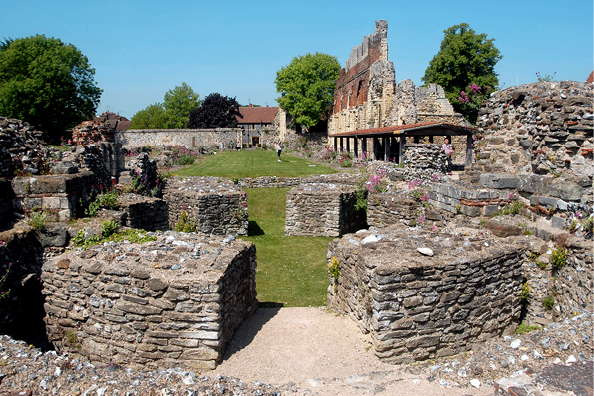
The ruins of St. Augustine’s Abbey.
Another 5 minutes east from St. Augustine’s Abbey on North Holmes Road is the oldest parish church in England and another UNESCO World Heritage Site St. Martin’s Church ( 01227/459-482). St. Martin’s was already more than a century old when Augustine arrived in A.D. 597, and parts of the structure date to Roman times, although much of it was rebuilt in the 17th century. It’s open daily from 9am to 5pm and admission is free.
01227/459-482). St. Martin’s was already more than a century old when Augustine arrived in A.D. 597, and parts of the structure date to Roman times, although much of it was rebuilt in the 17th century. It’s open daily from 9am to 5pm and admission is free.
Backtrack to Christ Church Gate on Burgate, and follow Butchery Lane to the Roman Museum ★ ( 01227/785-575). The period is chronicled through reconstructions, video presentations, and hands-on displays in this small but fascinating museum in the excavated Roman levels of the city between the cathedral and High Street. It’s open Monday through Saturday from 10am to 4pm year-round, and on Sunday (June–Oct only) from 1:30 to 4pm. Admission is £6 for adults, £5 for seniors and students; children 15 and under get in free (when entering with an adult).
01227/785-575). The period is chronicled through reconstructions, video presentations, and hands-on displays in this small but fascinating museum in the excavated Roman levels of the city between the cathedral and High Street. It’s open Monday through Saturday from 10am to 4pm year-round, and on Sunday (June–Oct only) from 1:30 to 4pm. Admission is £6 for adults, £5 for seniors and students; children 15 and under get in free (when entering with an adult).
Take St. George’s Street north to St. Margaret’s Street and turn left. The Canterbury Tales  , 23 St. Margaret’s St., in St. Margaret’s Church (
, 23 St. Margaret’s St., in St. Margaret’s Church ( 01227/454-888; www.canterburytales.org.uk), re-creates scenes from Geoffrey Chaucer’s spirited and sometimes bawdy stories about medieval pilgrims on their way to the city. Open daily 10am to 5pm (Nov–Feb until 4:30pm and July–Aug from 9:30am). Admission is £8 for adults, £7 for seniors and students, and £6 for children.
01227/454-888; www.canterburytales.org.uk), re-creates scenes from Geoffrey Chaucer’s spirited and sometimes bawdy stories about medieval pilgrims on their way to the city. Open daily 10am to 5pm (Nov–Feb until 4:30pm and July–Aug from 9:30am). Admission is £8 for adults, £7 for seniors and students, and £6 for children.
Organized Tours
Historic walks led by well-informed guides leave from the Tourist Information Centre on Sun Street daily at 2pm. Additional walks are held daily in July and August at 11:30am. The cost is £5 for adults, £4.50 students, and £3.50 children 11 and under.
The Canterbury River Navigation Company, Westgate Gardens ( 07816/760-869; www.crnc.co.uk), offers boat trips along the River Stour from Easter until late September or early October from the slipway at West Gate. Trips start at £8 for adults, £4 for children.
07816/760-869; www.crnc.co.uk), offers boat trips along the River Stour from Easter until late September or early October from the slipway at West Gate. Trips start at £8 for adults, £4 for children.

The River Stour runs through Canterbury.
The Crab & Winkle Way
This rural 7-mile (11-km) walking and cycling route starts at Canterbury West station and follows an abandoned railway line through forests, past lakes, and under Victorian bridges. Pick up a free detailed map covering the route and attractions at the Canterbury Tourist Information Centre or look on the website for the Crab & Winkle Line Trust (www.crabandwinkle.org). Downland Cycles ( 01227/479-643; www.downlandcycles.co.uk), located on St. Stephen’s Rd. just outside Canterbury West train station, rents bikes for £15 per day, plus £5 extra for helmets (Mon–Sat 9:30am–5:30pm).
01227/479-643; www.downlandcycles.co.uk), located on St. Stephen’s Rd. just outside Canterbury West train station, rents bikes for £15 per day, plus £5 extra for helmets (Mon–Sat 9:30am–5:30pm).
Shopping
There are a few independent arts and crafts shops on The King’s Mile, down Palace Street from the cathedral. Other places you might want to visit include The Goods Shed (see ‘Where to Eat’ below), a Victorian market outside Canterbury West train station, filled with produce sold by local farmers. Antique collectors will want to pop into Burgate Antiques, 23 Palace St. ( 01227/456-500), which is filled with objects from the 18th and 19th centuries.
01227/456-500), which is filled with objects from the 18th and 19th centuries.
Where to Eat
In the market next to Canterbury West train station, The Goods Shed ★ (bookings only  01227/459-153; www.thegoodsshed.co.uk) serves the freshest meat and produce available, and so the menu changes twice daily. Expect tender steaks and grilled seafood with seasonal vegetables, with mains priced around £12. On High Street adjacent to the Abode Canterbury Hotel, the Old Brewery Tavern ★★ (
01227/459-153; www.thegoodsshed.co.uk) serves the freshest meat and produce available, and so the menu changes twice daily. Expect tender steaks and grilled seafood with seasonal vegetables, with mains priced around £12. On High Street adjacent to the Abode Canterbury Hotel, the Old Brewery Tavern ★★ ( 01227/826-682) is a gastro-pub with respected chef Michael Caines in the kitchen (his namesake five-star restaurant is in the hotel as well) and thus the crisp fish, grilled steaks, and thick burgers are the best in town (main courses £7–£15). The Custard Tart, 35 St. Margaret’s St. (
01227/826-682) is a gastro-pub with respected chef Michael Caines in the kitchen (his namesake five-star restaurant is in the hotel as well) and thus the crisp fish, grilled steaks, and thick burgers are the best in town (main courses £7–£15). The Custard Tart, 35 St. Margaret’s St. ( 01227/765-178), is a tiny teashop a short stroll from the cathedral, with sublime, freshly made tarts and cakes.
01227/765-178), is a tiny teashop a short stroll from the cathedral, with sublime, freshly made tarts and cakes.
Nearby
Canterbury is just 7 miles (11km) from the historic seaside town of Whitstable, with its narrow medieval lanes and lovely ocean views. The seaside town of Broadstairs is 16 miles (26km) away and can be reached easily by train from Canterbury. The white cliffs of Dover are 18 miles (29km) away, where you can visit the extraordinary Dover Castle.
Chichester

Chichester, about 70 miles (113km) south of London near the Sussex coast, is a handsome cathedral city of medieval and 18th-century houses on beautiful lanes and streets. And despite the quiet, country air that prevails, Chichester also boasts four attractions, any one of which would draw visitors: a beautiful Norman cathedral, with a graceful steeple that can be seen from far out at sea; Pallant House, one of Britain’s finest galleries of modern art; the Chichester Festival Theatre, one of the country’s most acclaimed stages, regularly hosting England’s leading actors; and Fishbourne Roman Palace, a massive, 2,000-year-old domestic complex, graced with exquisite mosaics.
You can visit these sights while soaking in the pleasant atmosphere of Chichester, enjoying its lively streets and lanes that are still largely surrounded by Roman and medieval walls. Many of these byways, including the city’s four major thoroughfares, follow the grid the Romans laid out for their city of Noviomagus Reginorum, which later became the major city of the Kingdom of Sussex.
You can spend a pleasant full day in Chichester, but you may want to linger long enough to enjoy Evensong in the cathedral or even a performance at the Festival Theatre before returning to London. You could also combine a trip to Chichester with a visit to Brighton, and if you have a car you can easily drive to Lewes, with nearby Monk’s House and Charleston.
Essentials
Visitor Information
The Tourist Information Centre, 29a South St. ( 01243/775-888; www.visitchichester.org), is open most of the year Tuesday to Saturday from 9:15am to 5:15pm, with a slightly later opening of 10:15am on Mondays. Throughout April to September, it’s also open on Sundays from 10:30am to 3pm.
01243/775-888; www.visitchichester.org), is open most of the year Tuesday to Saturday from 9:15am to 5:15pm, with a slightly later opening of 10:15am on Mondays. Throughout April to September, it’s also open on Sundays from 10:30am to 3pm.
Scheduling Considerations
The Chichester Festival—one of the country’s leading arts festivals—takes place over three weeks from late June to early July, filling the city with musicians, artists, and theatrical performances ( 01243/795-718; www.chifest.org.uk).
01243/795-718; www.chifest.org.uk).
Getting There
By Train
From London Victoria, Southern trains ( 08451/272-920; www.southernrailway.com) depart every 30 minutes throughout the day for Chichester. The trip takes 11⁄2 hours, and the round-trip fare is around £27. Chichester train station is on the edge of the city center, a short walk from the cathedral and most other sights.
08451/272-920; www.southernrailway.com) depart every 30 minutes throughout the day for Chichester. The trip takes 11⁄2 hours, and the round-trip fare is around £27. Chichester train station is on the edge of the city center, a short walk from the cathedral and most other sights.
By Car
The drive from London takes about 2 hours, depending on traffic. Follow the A3 south to Hindhead, and from there a well-marked route on the A287 and A286 into Chichester.
Getting Around
Most of the center of Chichester is closed to traffic, making it a pleasure to stroll around. Fishbourne Roman Palace is about 1 mile (1.6km) west of the center. If you’re relying on public transportation you can take a train from Chichester, or bus no. 56 or 700.
Salterns Way
Salterns Way is a cycle-and-walking route from the center of Chichester to Chichester Harbour, a distance of about 11 miles (18km). The picturesque route passes through fields, woods, and marshlands, before reaching the Sussex coast. Pick up maps at the tourist office, and ask about bike rentals if you’d rather ride than walk.
A Day in Chichester
Chichester’s four main streets (appropriately named South, North, East, and West) bisect the city at right angles to one another and meet at the medieval Market Cross. From there, it’s a short walk down West Street to Chichester Cathedral ★★★ ( 01243/782-595; www.chichestercathedral.co.uk). Completed in 1123, the Norman cathedral is light and airy, and topped with a distinctive sharp spire, which was added 700 years later, after the first one collapsed. The art collection includes fine Romanesque sculptures, including a 12th-century relief of the raising of Lazarus and some exquisite 14th-century stained glass. A growing collection of modern art encompasses the abstract stained-glass window by the 20th-century artist Marc Chagall, and a stainless steel hand of Christ floating high in the nave, the work of Spanish artist Jaume Plensa. The cathedral is open daily from 7am to 6pm (until 7:15pm in summer). Free 45 minute guided tours are offered Monday through Saturday at 11:15am and 2:30pm.
01243/782-595; www.chichestercathedral.co.uk). Completed in 1123, the Norman cathedral is light and airy, and topped with a distinctive sharp spire, which was added 700 years later, after the first one collapsed. The art collection includes fine Romanesque sculptures, including a 12th-century relief of the raising of Lazarus and some exquisite 14th-century stained glass. A growing collection of modern art encompasses the abstract stained-glass window by the 20th-century artist Marc Chagall, and a stainless steel hand of Christ floating high in the nave, the work of Spanish artist Jaume Plensa. The cathedral is open daily from 7am to 6pm (until 7:15pm in summer). Free 45 minute guided tours are offered Monday through Saturday at 11:15am and 2:30pm.

The distinctive spire of Chichester Cathedral.
Nearby, the
Pallant House Gallery ★★★, 9 North Pallant ( 01243/774-557; www.pallant.org.uk), houses a strong collection of modern art, with works by artists including Picasso, Henry Moore, Graham Sutherland, and Peter Blake. It also holds the studio and archive of the German artist Hans Feibusch. Open Tuesday through Saturday 10am to 5pm (until 8pm on Thurs), and Sunday 12:30 to 5pm. Admission is £9 for adults, £2.30 for children 6 to 15; admission is half-price on Tuesdays and free on Thursday after 5pm.
01243/774-557; www.pallant.org.uk), houses a strong collection of modern art, with works by artists including Picasso, Henry Moore, Graham Sutherland, and Peter Blake. It also holds the studio and archive of the German artist Hans Feibusch. Open Tuesday through Saturday 10am to 5pm (until 8pm on Thurs), and Sunday 12:30 to 5pm. Admission is £9 for adults, £2.30 for children 6 to 15; admission is half-price on Tuesdays and free on Thursday after 5pm.
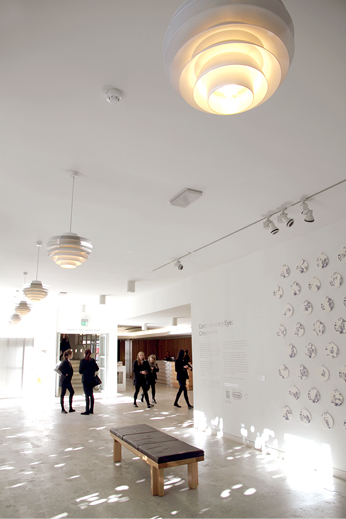
The Pallant House Gallery.
The stubby 1960s building at the end of North Street is the Chichester Festival Theatre ( 01243/784-437; www.cft.org.uk), one of the country’s top regional venues. Sir Laurence Olivier was its first artistic director, and the theater’s schedule is packed with performances by top British talent.
01243/784-437; www.cft.org.uk), one of the country’s top regional venues. Sir Laurence Olivier was its first artistic director, and the theater’s schedule is packed with performances by top British talent.
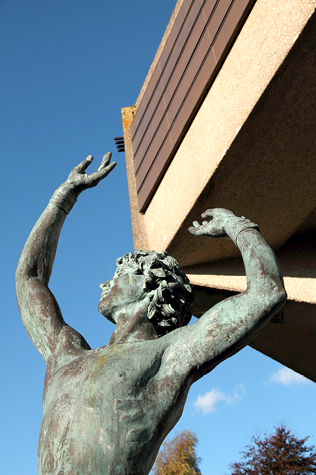
Sculpture outside the Chichester Festival Theatre.
In a quiet suburban neighborhood about 1 mile (1.6km) west of the city center, Fishbourne Roman Palace ★★★, Salthill Rd. ( 01243/785-859; www.sussexpast.co.uk/fishbourne), holds remarkable remnants of a grand Roman house. Built around a.d. 75, it was discovered only in 1960 when a water mains crew uncovered it by chance. The largest domestic Roman building found in Britain, it contains 20 well-preserved mosaic floors; in the most exuberant, a cupid rides on the back of a dolphin. Open daily March through October 10am to 5pm; November through February 10am to 4pm. Admission is £7.90 for adults, £7 for seniors and students, £4.20 for children. Local buses no. 56 or 700 head to Fishbourne from the bus stop at the cathedral (alight at Salthill Road), or you can catch a train from Chichester station that takes only three minutes (one-way ticket costs £2.30). Walking to the palace takes about 15 minutes and you can pick up a map at the tourist office.
01243/785-859; www.sussexpast.co.uk/fishbourne), holds remarkable remnants of a grand Roman house. Built around a.d. 75, it was discovered only in 1960 when a water mains crew uncovered it by chance. The largest domestic Roman building found in Britain, it contains 20 well-preserved mosaic floors; in the most exuberant, a cupid rides on the back of a dolphin. Open daily March through October 10am to 5pm; November through February 10am to 4pm. Admission is £7.90 for adults, £7 for seniors and students, £4.20 for children. Local buses no. 56 or 700 head to Fishbourne from the bus stop at the cathedral (alight at Salthill Road), or you can catch a train from Chichester station that takes only three minutes (one-way ticket costs £2.30). Walking to the palace takes about 15 minutes and you can pick up a map at the tourist office.
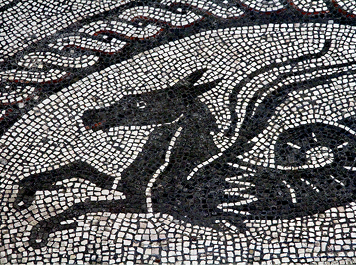
A well-preserved mosaic at Fishbourne Roman Palace.
Organized Tours
If you’re in the city on a Saturday, the Chichester City Guide walks are an excellent way to see the city. The tour takes just over an hour and costs £3.50. They begin at the Tourist Information Centre, 29a South St. ( 01243/775-888), each Saturday at 2:30pm.
01243/775-888), each Saturday at 2:30pm.
Shopping
The area around Market Cross has most high-street stores and a handful of more unique boutiques and independent stores. For local gifts, both the Cathedral and Pallant Gallery have shops where you can buy jewelry, art, and cards, while Art For All, The Square, Eastgate ( 01243/781-532), specializes in limited edition art prints. Montezuma’s, 29 East St. (
01243/781-532), specializes in limited edition art prints. Montezuma’s, 29 East St. ( 01243/537-385; www.montezumas.co.uk), is a temple of ethical artisan chocolate, and they also cater brilliantly for vegans.
01243/537-385; www.montezumas.co.uk), is a temple of ethical artisan chocolate, and they also cater brilliantly for vegans.
Where to Eat
Stop for lunch in the grand, vaulted room of the 12th-century The Buttery ★, 12a South St. ( 01243/537-033; www.thebuttery.org/chichester.htm): the sandwiches, baguettes, and filled potatoes start from £4.60. The pricier but atmospheric St. Martin’s Tea Rooms ★, 3 St. Martin’s St. (
01243/537-033; www.thebuttery.org/chichester.htm): the sandwiches, baguettes, and filled potatoes start from £4.60. The pricier but atmospheric St. Martin’s Tea Rooms ★, 3 St. Martin’s St. ( 01243/786-715; www.organictearooms.co.uk), uses only organic ingredients in its rustic, homemade food, served up in historic, beamed rooms, warmed by wood fires (lunch from £4.50 to £8.50). For a mid-morning caffeine-fix, pop into Amelie & Friends ★★, 31 North St. (
01243/786-715; www.organictearooms.co.uk), uses only organic ingredients in its rustic, homemade food, served up in historic, beamed rooms, warmed by wood fires (lunch from £4.50 to £8.50). For a mid-morning caffeine-fix, pop into Amelie & Friends ★★, 31 North St. ( 01243/771-444; www.amelieandfriends.com), and pick up one of the flavorsome salads (such as Chichester cucumber with poppy seed and red chili, or Jersey Royal potato salad with goat’s cheese) to have in the park later (£6.50 for two options).
01243/771-444; www.amelieandfriends.com), and pick up one of the flavorsome salads (such as Chichester cucumber with poppy seed and red chili, or Jersey Royal potato salad with goat’s cheese) to have in the park later (£6.50 for two options).
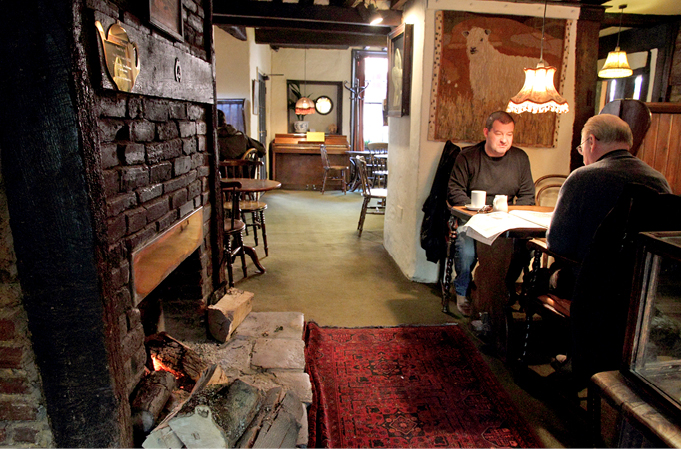
St. Martin’s Tea Rooms.
Nearby
Arundel is a small town 11 miles (18km) from Chichester dominated by the hulking walls of Arundel Castle ★★. First built in the 11th century, the castle is a stern fortress on the banks of the winding Arun River, first built to protect the country from invasion. Today it’s filled with antiques and works by Old Masters such as Van Dyck and Gainsborough. The castle has 40 acres (16 hectares) of grounds, including a walled kitchen garden as well as lush, formal gardens, all surrounded by parkland. The town of Arundel is worth a wander too, with a mixture of historic and modern architecture, and the castle park is a great place for a picnic. If you’re driving, the sandy “blue flag” beach of West Wittering (www.westwitteringbeach.co.uk) can be reached from Chichester on the A286 following the signs to The Witterings. There’s a cafe here selling ice creams and beach goods. You could also combine a trip to Chichester with a visit to Brighton, just 30 miles (48km) east along the A27 and easily reached by trains along the coast, which run about every 30 minutes. Or, if you have a car, you can easily visit nearby Lewes, and Monk’s House and Charleston.
Salisbury & Stonehenge
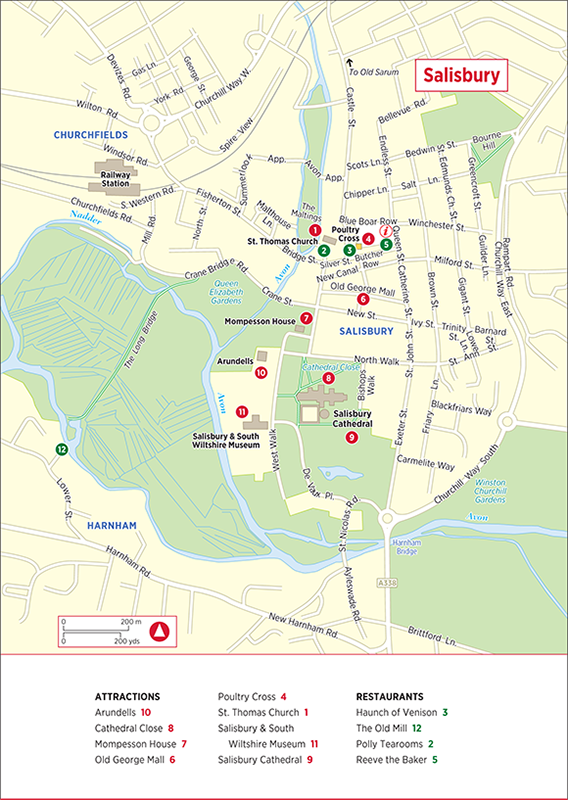
Long before you enter the city, the spire of Salisbury Cathedral comes into view just as John Constable and J. M. W. Turner captured it on canvas long ago. This is one of England’s most pleasant and unspoiled cities, and it’s little wonder so many painters and writers were drawn to it. Along with Gainsborough and Turner, Thomas Hardy and Anthony Trollope both spent time in Salisbury and set novels here. The half-timbered inns and houses lining the medieval lanes surround a still-lively marketplace.
Salisbury is actually two cities: Old Sarum and New Sarum. Old Sarum was an Iron Age fortification that the Romans took over and that later flourished as a Saxon, Danish, and Norman town well into the Middle Ages, when New Sarum, the city we know as Salisbury, began to grow up around the huge cathedral. William the Conqueror disbanded his troops in Old Sarum in 1070, when the Norman invasion of England was finally complete; the remains of his castle can still be seen.
Walk the city’s medieval streets and lanes, or mingle with the crowds in the marketplace. You may find yourself wishing you didn’t have to rush away from Salisbury—you can spend a full day enjoying the city sights, including a walk through the Water Meadows.
Lying in the valley of South Wiltshire’s River Avon, Salisbury’s location makes it an excellent starting point for visits to the ancient stone circles at Stonehenge and Avebury.
Essentials
Visitor Information
The Salisbury Information Centre, in the marketplace on Fish Row ( 01722/334-956; www.visitwiltshire.co.uk/salisbury), provides maps and information. Open September to May Monday through Saturday 9:30am to 5:30pm, and between June and August it’s also open Sunday 11am to 3pm.
01722/334-956; www.visitwiltshire.co.uk/salisbury), provides maps and information. Open September to May Monday through Saturday 9:30am to 5:30pm, and between June and August it’s also open Sunday 11am to 3pm.
Scheduling Considerations
St. George’s Day in April is a traditional medieval celebration of the city’s patron saint, where you can watch St. George slaying the dragon in the Wiltshire mummers play, and take in acrobats and fireworks. Note: The festival isn’t always on St. George’s Day itself (April 23); check ahead with the Tourist Information Centre.
During the annual Salisbury International Arts Festival ( 01722/332-977; www.salisburyfestival.co.uk) the city drapes itself in banners, and street theater—traditional and unusual—is offered everywhere. There are also symphony and chamber music concerts in Salisbury Cathedral, children’s events, and much more. It takes place from mid-May to the beginning of June.
01722/332-977; www.salisburyfestival.co.uk) the city drapes itself in banners, and street theater—traditional and unusual—is offered everywhere. There are also symphony and chamber music concerts in Salisbury Cathedral, children’s events, and much more. It takes place from mid-May to the beginning of June.
Getting There
By Train
Trains for Salisbury depart every 30 minutes from London Waterloo; the trip takes around 11⁄2 hours, fares start at £35. Salisbury train station is at the western edge of the city center, off Fisherton Street, within easy walking distance of the city center.
By Car
The quickest route from London is on the M3, and then the A30. The trip takes about 11⁄2 hours. Convenient car parks near the city center are Central Car Park, north of the marketplace on the west side of the River Avon; and Culver Street Car Park, a few blocks northeast of the Cathedral Close. Fees at most carparks near the center are around £5 per day.
By Bus
National Express buses ( 08717/818-178; www.nationalexpress.com) leave London Victoria bus station for Salisbury every 2 to 3 hours. The bus ride takes at least 3 hours and sometimes requires a change at Southampton or Bristol: fares cost about £18 round-trip. The bus station is at the east end of the marketplace, which is within easy walking distance to the cathedral.
08717/818-178; www.nationalexpress.com) leave London Victoria bus station for Salisbury every 2 to 3 hours. The bus ride takes at least 3 hours and sometimes requires a change at Southampton or Bristol: fares cost about £18 round-trip. The bus station is at the east end of the marketplace, which is within easy walking distance to the cathedral.
Getting Around
Salisbury is compact and easy to walk, all the more so because many of its main streets are pedestrianized. If you require a taxi, try City Cabs ( 01722/423-000).
01722/423-000).
A Day in Salisbury
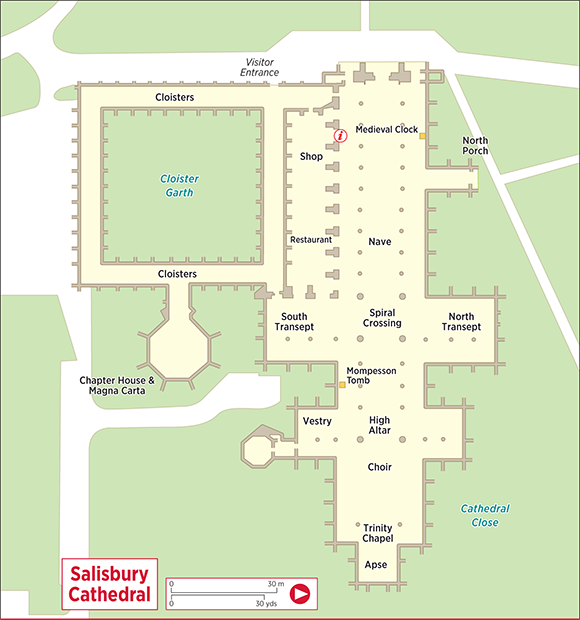
The best place to begin an exploration of Salisbury is the heart of the city—the marketplace ★★, where venders have congregated since 1227 and continue to peddle their wares every Tuesday and Saturday. The medieval Poultry Cross, so called because it once marked the poultry section of the market, along with the narrow medieval lanes—Fish Street and Butcher Row—are markers of past trade here.
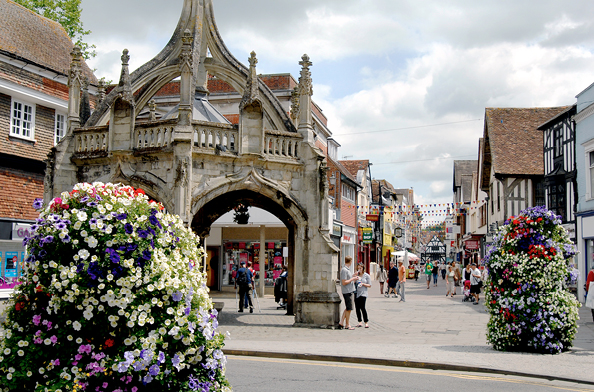
The medieval Poultry Cross.
Just to the west of the marketplace, off Silver Street, is 700-year-old St. Thomas Church ★. Step inside to see the terrifying painting Doom, which was probably the gift of a medieval pilgrim to the cathedral. Dating to 1475, it hangs over the chancel arch and depicts ordinary folk rising from their graves and marching toward heaven or hell. Once common in English churches, such depictions of the Last Judgment were largely destroyed during the Reformation and are now quite rare.
Nearby, High Street leads south to the main cathedral, past half-timbered buildings. The Old George Mall (near the corner of New St.) is a former inn that was already 300 years old when the diarist Samuel Pepys stayed here in 1668. Nowadays it leads into an open-air shopping center with many popular highstreet stores (www.oldgeorgemall.co.uk).
As you near the Cathedral you’ll see Cathedral Close ★★ ahead of you, like a small city protected by stone walls and medieval gates. From High Street, you’ll pass through High Street Gate, with elaborate stonework above its old archway. The entrance from Queen Street, to the east, is through St. Anne’s Gate, where George Frederick Handel is said to have given his first recital in England in a room over the gatehouse. Inside the close, you can tour the perfectly preserved Mompesson House ★★ ( 01722/335-659; www.nationaltrust.org.uk). Built in 1701, it still has its original intricate plasterwork and furnishings, including a huge collection of 18th-century glassware. The house is open March through October Saturday to Wednesday from 11am to 5pm. Admission is £5.20 for adults and £2.60 for children.
01722/335-659; www.nationaltrust.org.uk). Built in 1701, it still has its original intricate plasterwork and furnishings, including a huge collection of 18th-century glassware. The house is open March through October Saturday to Wednesday from 11am to 5pm. Admission is £5.20 for adults and £2.60 for children.
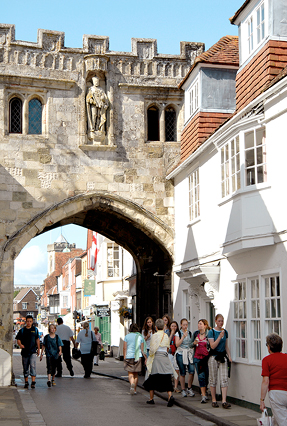
High Street Gate.
Near it is Arundells, a sturdy 18th-century stone building that served as the home of former Prime Minister Sir Edward Heath in the 1980s. Still filled with Sir Edward’s many artworks, it’s open for 45-minute guided tours April through October Saturday to Tuesday 11:30am to 5:30pm. Admission costs £8.
Not far from Arundells, the Salisbury & South Wiltshire Museum, 65 The Close ( 01722/332-151; www.salisburymuseum.org.uk), occupies a magnificent 11th-century building with a slightly haphazard collection of artifacts and information about the city and Stonehenge. It’s open Monday to Saturday from 10am to 5pm (July–Aug also Sun 2–5pm). Admission is £6 adults, £4 seniors and students, £2 children 5 to 16.
01722/332-151; www.salisburymuseum.org.uk), occupies a magnificent 11th-century building with a slightly haphazard collection of artifacts and information about the city and Stonehenge. It’s open Monday to Saturday from 10am to 5pm (July–Aug also Sun 2–5pm). Admission is £6 adults, £4 seniors and students, £2 children 5 to 16.
Built over 38 years, from 1220 to 1258, the thoroughly Gothic Salisbury Cathedral ★★★ ( 01722/555-120; www.salisburycathedral.org.uk), made of cream-colored limestone, is an impressive sight. The elegant spire is 404 feet (123m) high, the tallest in the land, and can be seen from miles away, while the mechanical clock in the north aisle is one of the oldest pieces of working machinery in the world—it’s been telling time since 1386. The octagonal Chapter House holds a copy of the Magna Carta (see below) amid stone friezes from the 13th century that tell Old Testament stories. The cathedral is open daily from 9am to 5pm (to 5:30pm June–Aug). There’s no admission but a donation is requested of £5 for adults. Free tours are offered throughout the day; the tower tour (£8.50) climbs 332 winding steps past medieval scaffolding for amazing city views.
01722/555-120; www.salisburycathedral.org.uk), made of cream-colored limestone, is an impressive sight. The elegant spire is 404 feet (123m) high, the tallest in the land, and can be seen from miles away, while the mechanical clock in the north aisle is one of the oldest pieces of working machinery in the world—it’s been telling time since 1386. The octagonal Chapter House holds a copy of the Magna Carta (see below) amid stone friezes from the 13th century that tell Old Testament stories. The cathedral is open daily from 9am to 5pm (to 5:30pm June–Aug). There’s no admission but a donation is requested of £5 for adults. Free tours are offered throughout the day; the tower tour (£8.50) climbs 332 winding steps past medieval scaffolding for amazing city views.

The thoroughly Gothic Salisbury Cathedral.
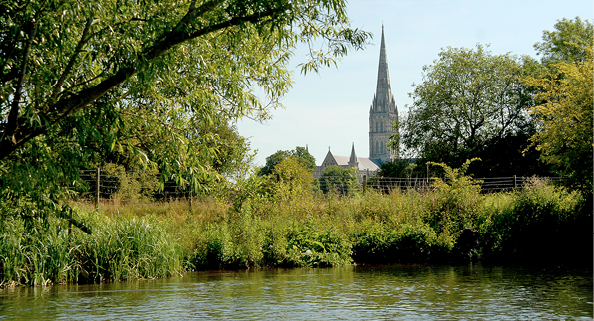
View of Salisbury Cathedral from the Water Meadows.
Organized Tours
The highly informative 11⁄2-hour Salisbury City Walk ( 01725/518-658; £4) begins at the Tourist Information Centre in Fish Row at 11am daily from April to October (Nov–Mar Sat and Sun only). You’ll get an earful of tidbits about commerce in the bustling medieval city, the building of the cathedral, and life within Cathedral Close.
01725/518-658; £4) begins at the Tourist Information Centre in Fish Row at 11am daily from April to October (Nov–Mar Sat and Sun only). You’ll get an earful of tidbits about commerce in the bustling medieval city, the building of the cathedral, and life within Cathedral Close.
The Magna Carta
Housed in the Chapter House at Salisbury Cathedral is one of England’s most treasured documents. Written in 1215 by a group of feudal barons, and passed into law in 1225, Magna Carta was written to limit royal power and create new rights for “freemen.” Among other things, it protects land rights and guarantees freedoms for the Church from arbitrary actions by the monarchy. The influential document is seen as a forefather of later modern democratic documents, such as the U.S. Constitution.
 Stonehenge ★★★
Stonehenge ★★★
The world’s most renowned prehistoric site, a stone circle of pillars and lintels, has risen above the Salisbury Plain for almost 4,000 years. Why these stones are here is still unknown, but archaeologists believe it was a meeting place and a ceremonial center. Whatever the reason for the presence of these great slabs, getting them here wasn’t easy. The stones in the Inner Circle, the oldest part of the monument, are from the Prescelly Mountains in southwestern Wales, 240 miles (385km) away, and theories hold that they were dragged overland on rollers and sledges and floated over the sea and down rivers.
These days the site is a victim of its own popularity and frequently over-crowded. As you pull into the carpark, you’re greeted by cheap-looking concession stands and confusing signs. Matters improve as you turn your back on these and follow a walkway to the stones themselves. The walkway leads you in a large circle around the stones—you’re kept back from the rocks by a metal fence, but you do get a decent view of them as you stroll around. If you’re traveling by car or taxi, try to be
at the site when the gates open or arrive an hour or so before closing—it’s likely the tour groups, at least, will be gone, and you can enjoy the spectacle of soft light playing over the mysterious stones in relative peace and quiet.
There’s no regular bus service to Stonehenge, but you can take a tour bus; Stonehenge Tours ( 01983/827-005; www.thestonehengetour.info) depart from the Salisbury train and bus station daily for Old Sarum and Stonehenge. Buses leave the train station from late May through August, every half-hour from 9:30am to 5pm; September to mid-October, every hour between 10am and 4pm; and mid-October to late May, every hour between 10am and 2pm. The cost is £18 with admission to Stonehenge; £9 for children.
01983/827-005; www.thestonehengetour.info) depart from the Salisbury train and bus station daily for Old Sarum and Stonehenge. Buses leave the train station from late May through August, every half-hour from 9:30am to 5pm; September to mid-October, every hour between 10am and 4pm; and mid-October to late May, every hour between 10am and 2pm. The cost is £18 with admission to Stonehenge; £9 for children.
8 miles (13km) north of Salisbury off the A360.  0870/333-1181. www.english-heritage.org.uk. Mar 16–May daily 9:30am–6pm; June–Aug daily 9am–7pm; Sept–Oct 15 daily 9:30am–6pm; Oct 16–Mar 15 daily 9:30am–5pm. Admission £7.50 adults, £6.80 seniors and students, £4.50 children 5–15.
0870/333-1181. www.english-heritage.org.uk. Mar 16–May daily 9:30am–6pm; June–Aug daily 9am–7pm; Sept–Oct 15 daily 9:30am–6pm; Oct 16–Mar 15 daily 9:30am–5pm. Admission £7.50 adults, £6.80 seniors and students, £4.50 children 5–15.
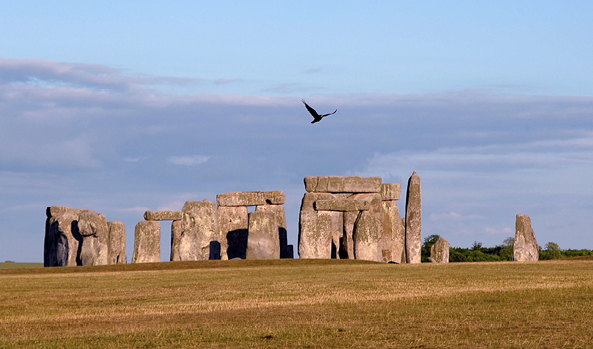
Shopping
At the center of the city, the bustling Charter Market ★ is flowing with fresh produce and general goods on Tuesday and Saturday, while the Wiltshire Farmers’ Market is held fortnightly on Wednesdays (www.visitwiltshire.co.uk). The National Trust Shop, 41 High St. ( 01722/331-884), housed within the cathedral, carries gifts, books, CDs, and children’s toys. Local interest books and walking maps are available in the independent Cross Keys Bookshop, 2 Cross Keys Chequer (
01722/331-884), housed within the cathedral, carries gifts, books, CDs, and children’s toys. Local interest books and walking maps are available in the independent Cross Keys Bookshop, 2 Cross Keys Chequer ( 01722/326-131).
01722/326-131).
Walking Around Salisbury
A well-maintained footpath traverses the Water Meadows ★ between Mill Road and the old Harnham Mill, crossing the River Avon and affording wonderful views toward the cathedral. A walk through the meadows and back to the city center covers a little less than 2 miles (3km). For a longer excursion, rent a bike from Hayball Cycles, 26–30 Winchester St. ( 01722/411-378), for a spin around the city and onto a series of public footpaths that wind through the countryside; bike hire is from £12 a day.
01722/411-378), for a spin around the city and onto a series of public footpaths that wind through the countryside; bike hire is from £12 a day.
Where to Eat
You can equip yourself with picnic fodder and delicious pastries at Reeve the Baker, 2 Butcher Row ( 01722/320-367), while cheese, fruit, and other produce can be picked up from local producers at the Charter Market (see above). The Polly Tearooms, 8 St. Thomas Square (
01722/320-367), while cheese, fruit, and other produce can be picked up from local producers at the Charter Market (see above). The Polly Tearooms, 8 St. Thomas Square ( 01722/336-037), offers a bright and atmospheric spot for sandwiches and cakes, with tables outside for sunny days. For a pub lunch, the Haunch of Venison ★, Town Path, Harnham (
01722/336-037), offers a bright and atmospheric spot for sandwiches and cakes, with tables outside for sunny days. For a pub lunch, the Haunch of Venison ★, Town Path, Harnham ( 01722/327-517), is a flint-and-stone building that was once England’s first paper mill. Now a friendly hotel and inn, it dishes out home-style cooking, with a choice of focaccia rolls and ploughman’s lunches at lunchtime (£5.25 to £8.95).
01722/327-517), is a flint-and-stone building that was once England’s first paper mill. Now a friendly hotel and inn, it dishes out home-style cooking, with a choice of focaccia rolls and ploughman’s lunches at lunchtime (£5.25 to £8.95).
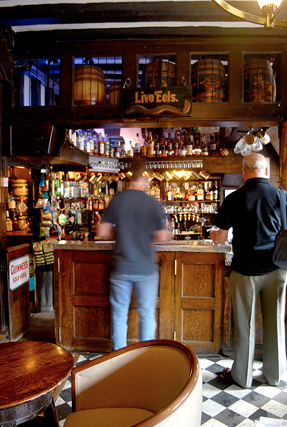
Salisbury’s oldest pub, the Haunch of Venison.
Nearby
With a mysterious stone circle bigger—if less dramatic—than the one at Stonehenge, the town of Avebury ★ ( 01672/539-250), which houses one of Britain’s most important archaeological collections, including material from excavations at Avebury, plus artifacts from other prehistoric digs. It’s open April through October daily 10am to 6pm; 10am to 4:30pm otherwise. Admission costs £4.40 for adults, £2.20 children 5 to 14. You can also combine a visit with Winchester, below.
01672/539-250), which houses one of Britain’s most important archaeological collections, including material from excavations at Avebury, plus artifacts from other prehistoric digs. It’s open April through October daily 10am to 6pm; 10am to 4:30pm otherwise. Admission costs £4.40 for adults, £2.20 children 5 to 14. You can also combine a visit with Winchester, below.
A few miles north from Salisbury, Old Sarum ( 0117/9750-700; www.english-heritage.org.uk), off the A345, Castle Road, was once a bustling castle town until the 15th century when Salisbury grew up around the cathedral. Nowadays you can visit the moody ruins of the Norman castle, cathedral, and Bishop’s Palace inside the sturdy fortifications. To get there you can walk on a well-marked footpath along the river, or take a bus (local bus nos. 5, 6, 7, 8, and 9 stop nearby; the fare is about £3). The site is open April to June and September daily 10am to 5pm; July and August daily 9am to 6pm; October and February to March daily 10am to 4pm; November to January daily 11am to 3pm. Admission costs £3.70 for adults, £3.30 for seniors and students, and £2.20 for children 5 to 15.
0117/9750-700; www.english-heritage.org.uk), off the A345, Castle Road, was once a bustling castle town until the 15th century when Salisbury grew up around the cathedral. Nowadays you can visit the moody ruins of the Norman castle, cathedral, and Bishop’s Palace inside the sturdy fortifications. To get there you can walk on a well-marked footpath along the river, or take a bus (local bus nos. 5, 6, 7, 8, and 9 stop nearby; the fare is about £3). The site is open April to June and September daily 10am to 5pm; July and August daily 9am to 6pm; October and February to March daily 10am to 4pm; November to January daily 11am to 3pm. Admission costs £3.70 for adults, £3.30 for seniors and students, and £2.20 for children 5 to 15.
The home of the Earl and Duchess of Pembroke, Wilton House ( 01722/746-720; www.wiltonhouse.com), is 3 miles (5km) northwest of Salisbury on the A30, in Wilton village. This is a well-maintained 17th-century house containing paintings by Anthony Van Dyck, Peter Paul Rubens, and Pieter Bruegel. The River Avon flows through the gardens (home to giant Lebanon cedars planted in 1630), and is spanned by a Palladian bridge: It’s open May to August Sunday to Thursday 11:30am to 4:30pm (last admission at 3:45pm). Admission is £14 for adults, £11.25 seniors and students, and £7.50 for children 5 to15.
01722/746-720; www.wiltonhouse.com), is 3 miles (5km) northwest of Salisbury on the A30, in Wilton village. This is a well-maintained 17th-century house containing paintings by Anthony Van Dyck, Peter Paul Rubens, and Pieter Bruegel. The River Avon flows through the gardens (home to giant Lebanon cedars planted in 1630), and is spanned by a Palladian bridge: It’s open May to August Sunday to Thursday 11:30am to 4:30pm (last admission at 3:45pm). Admission is £14 for adults, £11.25 seniors and students, and £7.50 for children 5 to15.
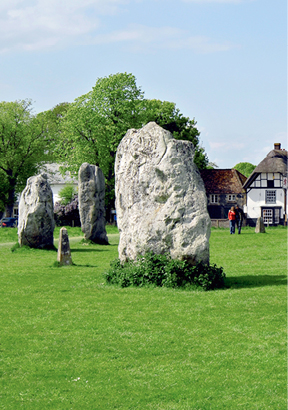
Winchester

A bustling, attractive cathedral city kept youthful by the presence of a major arts university, Winchester’s venerable historic pedigree stretches back two millennia. An important Roman military headquarters, it became capital of the ancient kingdom of Wessex after the Romans withdrew from Britain, and remained the most important city in England up until the time of the Norman Conquest in 1066. Winchester Cathedral, a magnificent Gothic edifice, soars above the city’s low roofs and makes a graceful focus to its appealing city center.
Jane Austen fans can visit the great novelist’s home in the nearby village of Chawton, and her grave in Winchester Cathedral. You’ll also enjoy walking the streets, strolling through the water meadows that extend behind the cathedral to the banks of the River Itchen, and just soaking in the atmosphere of a well-preserved English cathedral city.
If you’re really ambitious and can’t get your fill of cathedrals and medieval charm, you can spend the morning in Winchester and the afternoon in nearby Salisbury, only 20 miles (32km) west, or vice versa.
Essentials
Visitor Information
Based in the huge neo-gothic Guildhall building, the Tourist Information Centre, High St. ( 01962/840-500; www.visitwinchester.co.uk), is open Monday through Saturday 10am to 5pm, and Sunday 11am to 4pm (closed Sun Oct–Apr). It offers a handy bicycle hire service, and a shop selling local art and crafts.
01962/840-500; www.visitwinchester.co.uk), is open Monday through Saturday 10am to 5pm, and Sunday 11am to 4pm (closed Sun Oct–Apr). It offers a handy bicycle hire service, and a shop selling local art and crafts.
Scheduling Considerations
Winchester is a busy working city all year round. Crowds are at their highest in summer, but it rarely gets overrun with visitors.
Getting There
By Train
Trains go to Winchester from London Waterloo every 30 minutes. The journey takes 1 hour and a round-trip fare costs around £30. Winchester train station is about a 10 minute walk from the cathedral and other major sights. There’s a park and ride system to and from the train station (£3; tickets valid all day) but take care to get off at the city center stops (about 5 minutes from the station), or you could end up in the suburbs.
By Bus
National Express ( 08717/818-178; www.nationalexpress.com) runs direct buses from London Victoria bus station to Winchester about every 2 hours. The journey takes around 11⁄2 hours and costs £5.50 to £16, depending on when you book.
08717/818-178; www.nationalexpress.com) runs direct buses from London Victoria bus station to Winchester about every 2 hours. The journey takes around 11⁄2 hours and costs £5.50 to £16, depending on when you book.
By Car
From London, the M3 goes directly to Winchester. The trip takes about 11⁄2 hours. Don’t even think about driving into the center—parking can be problematic. Look out for the two large pay carparks at the edge of the center on Tanner Street and Gordon Road and two on the east side of the cathedral (expect to pay around £5 a day). Parking is free on Sundays.
Getting Around
The center of Winchester is about a half-mile (0.8km) from the train station, and so you can easily walk. There are also taxis at the station and at ranks near the cathedral; or you can call Winchester Taxis ( 07919/181-403) or Steve’s Taxis (
07919/181-403) or Steve’s Taxis ( 01962/849-953).
01962/849-953).
A Day in Winchester
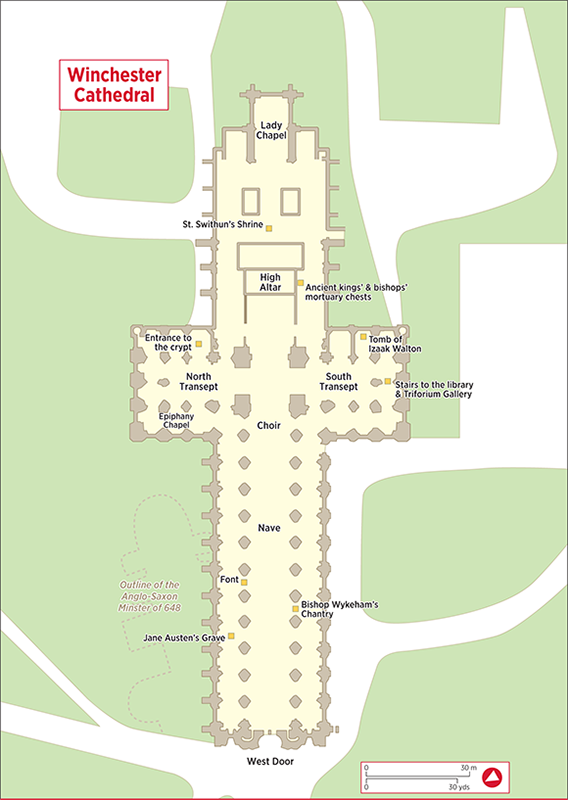
Begin your tour at Winchester Cathedral ★★★ ( 01962/857-200; www.winchester-cathedral.org.uk). The 900-year-old structure, begun in 1079, is graced with the longest nave of any church in Europe, and as befits a cathedral that was for so long a symbol of power and might, is the repository of many historic treasures. Above the 15th-century Great Screen are mortuary chests containing the remains of a dozen Saxon kings. A more recent, but no less revered grave, is that of Jane Austen; look for the simple, stone marker laid into the floor in the north aisle. Nearby, a 12th-century font tells the story of St. Nicholas (270–343), the inspiration for Santa Claus, and on display in the library is the Winchester Bible, an extraordinary illuminated manuscript. The cathedral is open Monday through Saturday from 9:30am to 5pm and Sunday from 12:30 to 3pm. Admission is £6.50 for adults, £5 seniors, and free for under-16s. The price includes a 1-hour tour (hourly, Mon–Sat 10am–3pm; during winter months 10:15am, 12:15pm, and 2:15pm).
01962/857-200; www.winchester-cathedral.org.uk). The 900-year-old structure, begun in 1079, is graced with the longest nave of any church in Europe, and as befits a cathedral that was for so long a symbol of power and might, is the repository of many historic treasures. Above the 15th-century Great Screen are mortuary chests containing the remains of a dozen Saxon kings. A more recent, but no less revered grave, is that of Jane Austen; look for the simple, stone marker laid into the floor in the north aisle. Nearby, a 12th-century font tells the story of St. Nicholas (270–343), the inspiration for Santa Claus, and on display in the library is the Winchester Bible, an extraordinary illuminated manuscript. The cathedral is open Monday through Saturday from 9:30am to 5pm and Sunday from 12:30 to 3pm. Admission is £6.50 for adults, £5 seniors, and free for under-16s. The price includes a 1-hour tour (hourly, Mon–Sat 10am–3pm; during winter months 10:15am, 12:15pm, and 2:15pm).
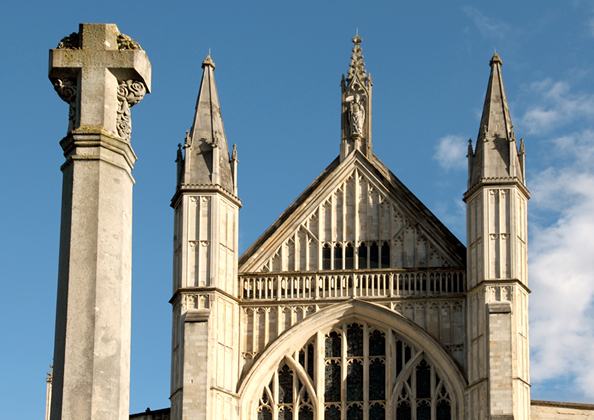
Winchester Cathedral.

Jane Austen's gravestone in the cathedral.
On College Street, marked by a plaque, is Jane Austen’s House. The writer lived in the tiny village of Chawton for most of her life, but moved here shortly before she died at the age of 42 in 1817. (You can’t go inside, but you can visit her house in Chawton).
On nearby Kingsgate Street Winchester College ★★, founded in 1382, is the oldest public school in England. The chapel, cloister, scholars’ dining room, and a 17th-century schoolroom are open by 45-minute guided tours only (Tues and Thurs 10:45am and noon; Mon, Wed, Fri, and Sat 10:45am, noon, 2:15, and 3:30pm; Sun 2:15 and 3:30pm.
At the far end of College Street, you can take a short walk along the narrow River Itchen and its water meadows. Ambles along the river and across these green meadows inspired the poet John Keats to write his poem To Autumn, and the path is aptly called “Keats’ Walk.” To the left are the evocative remains of Wolvesey Castle ★, where Queen Mary I and Philip of Spain held their wedding breakfast in 1554. Enough walls, arches, and foundations remain to give an idea of how grand it must once have been. You can roam through the evocative ruins from April through the end of September, daily 10am to 5pm; admission is free (www.english-heritage.org.uk).
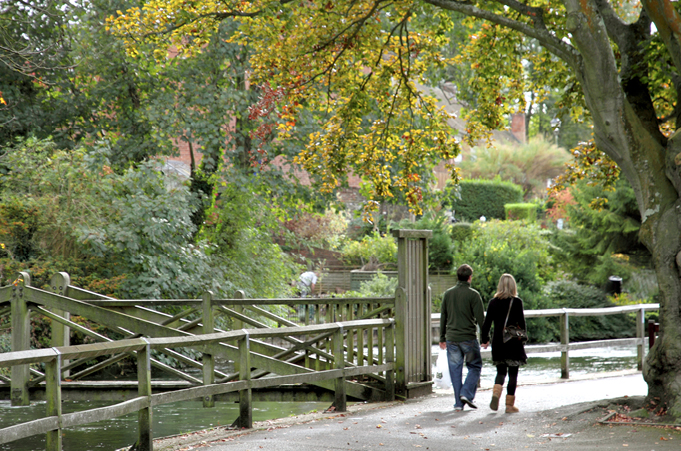
Walkers beside the River Itchen.
Winchester City Mill ★  (
( 01962/870-057; www.nationaltrust.org.uk) makes an appealing diversion for families; you can still see the original 18th-century machinery at work, plus there are interactive exhibitions and a pretty island garden, home to kingfishers, otters, and water voles. Open daily mid-March through late December 10:30am to 5pm. Admission costs £3.60 for adults and £2 for children.
01962/870-057; www.nationaltrust.org.uk) makes an appealing diversion for families; you can still see the original 18th-century machinery at work, plus there are interactive exhibitions and a pretty island garden, home to kingfishers, otters, and water voles. Open daily mid-March through late December 10:30am to 5pm. Admission costs £3.60 for adults and £2 for children.
The excellent City Museum ( 01962/863-064) on the Square nearby, has a fine Roman mosaic as centerpiece and is dedicated to Winchester’s history from the same period. It’s open April to October Monday to Saturday 10am to 5pm, Sunday noon to 5pm (hours are slightly shorter in winter). Admission is free.
01962/863-064) on the Square nearby, has a fine Roman mosaic as centerpiece and is dedicated to Winchester’s history from the same period. It’s open April to October Monday to Saturday 10am to 5pm, Sunday noon to 5pm (hours are slightly shorter in winter). Admission is free.
All that remains of once-mighty Winchester Castle is the Great Hall ★ ( 01962/846-476) on Castle Avenue. The first English parliament met here in 1246, but a more illustrious claim is made for the colorful, 13th-century painted table that hangs inside. Folklore once held it to be King Arthur’s round table, though in reality it probably merely served as inspiration for the tale. The hall is open daily 10am to 5pm and admission is free.
01962/846-476) on Castle Avenue. The first English parliament met here in 1246, but a more illustrious claim is made for the colorful, 13th-century painted table that hangs inside. Folklore once held it to be King Arthur’s round table, though in reality it probably merely served as inspiration for the tale. The hall is open daily 10am to 5pm and admission is free.
Organized Tours
Every day during the summer, the Tourist Information Centre operates two useful walking tours: Kings and Castles at 11am and Mitres and Mortarboards at 2pm. Each tour takes from 1 to 11⁄2 hours and costs £4.50 adults (children are free). You can find details at the center.
Shopping
A day could easily be spent perusing the many shops of Winchester. For unique art, jewelry, and gifts, Kingsgate Street and Parchment Street are superb places to start. Elsewhere of note, the Winchester Bookshop, 10a St. George’s St. ( 01962/855-630), is a bibliophile’s dream: three floors crammed with secondhand and antiquarian books, along with old prints. Middle Brook Street is the location of the General Market (Thursday to Saturday, 9am to 5pm) selling local food and crafts, and the Taste of the South (Wednesday 9am to 4pm) for specialty local foods.
01962/855-630), is a bibliophile’s dream: three floors crammed with secondhand and antiquarian books, along with old prints. Middle Brook Street is the location of the General Market (Thursday to Saturday, 9am to 5pm) selling local food and crafts, and the Taste of the South (Wednesday 9am to 4pm) for specialty local foods.
Where to Dine
Dating from 1450, the Chesil Rectory ★, 1 Chesil St. ( 01962/851-555; www.chesilrectory.co.uk), is in a low-beamed, timber-framed building thought to be the oldest house in Winchester. Made with locally sourced ingredients, a two-course lunch is priced at £15.95. On Southgate St., The Green Man ★ (
01962/851-555; www.chesilrectory.co.uk), is in a low-beamed, timber-framed building thought to be the oldest house in Winchester. Made with locally sourced ingredients, a two-course lunch is priced at £15.95. On Southgate St., The Green Man ★ ( 01962/866-809) is a relaxed, stylish Victorian pub serving substantial sandwiches and bar snacks at lunchtime, most £10 and under. The Wykeham Arms ★★, 75 Kingsgate St. (
01962/866-809) is a relaxed, stylish Victorian pub serving substantial sandwiches and bar snacks at lunchtime, most £10 and under. The Wykeham Arms ★★, 75 Kingsgate St. ( 01962/853-834), is a cozy 18th-century coaching inn with a very British menu of savory pies or seared scallops with cauliflower puree, with mains priced around £15.
01962/853-834), is a cozy 18th-century coaching inn with a very British menu of savory pies or seared scallops with cauliflower puree, with mains priced around £15.
Nearby
Fifteen miles (24km) from Winchester, the charming house known as Chawton Cottage is where Jane Austen spent the last 7 years of her life. Here she wrote many books, including Emma. Now the Jane Austen House Museum ★★ ( 01420/832-62; www.jane-austens-house-museum.org.uk), the cottage is filled with antiques and memorabilia including Austen’s needlework and jewelry. From Winchester, Chawton is on the A31. It’s open daily from 10am to 5pm. Admission is £7 for adults, £6 seniors and students, and £2 for children.
01420/832-62; www.jane-austens-house-museum.org.uk), the cottage is filled with antiques and memorabilia including Austen’s needlework and jewelry. From Winchester, Chawton is on the A31. It’s open daily from 10am to 5pm. Admission is £7 for adults, £6 seniors and students, and £2 for children.
Twelve miles (19km) from Winchester, Mottisfont Abbey ★ ( 01794/340-757; www.nationaltrust.org.uk/mottisfont), near the town of Romsey, started life in the 13th century as an Augustinian priory before being transformed (thanks to the Reformation) into a grand, riverside private home. The gardens are radiant in the height of summer, especially the walled rose garden ★★, where perfumes and colors are in full effect. It’s open late February through October daily 10am to 5pm. Admission costs £7.60 adults and £3.80 children.
01794/340-757; www.nationaltrust.org.uk/mottisfont), near the town of Romsey, started life in the 13th century as an Augustinian priory before being transformed (thanks to the Reformation) into a grand, riverside private home. The gardens are radiant in the height of summer, especially the walled rose garden ★★, where perfumes and colors are in full effect. It’s open late February through October daily 10am to 5pm. Admission costs £7.60 adults and £3.80 children.
Salisbury is 20 miles (32km) west of the city and can be reached via train, in just over 11⁄2 hours, with a change in Southampton. If you’re driving, follow the A30 and A272 between the two cities; the trip by car takes only about 45 minutes.